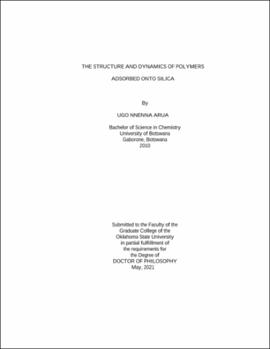| dc.contributor.advisor | Blum, Frank D. | |
| dc.contributor.author | Arua, Ugo Nnenna | |
| dc.date.accessioned | 2023-09-22T18:31:52Z | |
| dc.date.available | 2023-09-22T18:31:52Z | |
| dc.date.issued | 2021-05 | |
| dc.identifier.uri | https://hdl.handle.net/11244/339611 | |
| dc.description.abstract | Polymer nano-composites have been studied extensively due to their large scope of applications. These studies have been undertaken to understand the properties of materials which depend on both of the components, as well as their interfacial properties. In this study, the polymers of interest were poly(lauryl methacrylate), a copolymer – poly(styrene-r-methyl methacrylate-d₃), poly(methyl methacrylate), and poly(vinyl pyrrolidone). | |
| dc.description.abstract | The effects of adsorption on poly(lauryl methacrylate) (PLMA), a side-chain crystalline polymer, on silica on its side chain crystallinity were investigated using FTIR and differential scanning calorimetry (DSC) measurements. Adsorption caused a disruption of the side-chain crystallinity in the tightly-bound layer of the polymer without affecting its glass transition temperature. It also changed the packing of the hydrophobic side chains for tightly-bound polymer. | |
| dc.description.abstract | Solid-state deuterium NMR spectroscopy was used to observe the dynamics of bulk and adsorbed poly(styrene-r-methyl methacrylate-d3). The ²H-NMR spectra of adsorbed samples showed significant differences from those of the bulk; decreased segmental mobility of the MMA-d₃ units was clear in all the small adsorbed amounts at all polymer compositions. This work led to the conclusion that methyl methacrylate units preferentially adsorb to the silica surface. | |
| dc.description.abstract | Poly(methyl methacrylate) polymers with different molecular masses were adsorbed on silica and studied using FTIR and temperature modulated DSC. The effect of the surface on the polymer increased with decreasing molecular mass. Lower molecular mass polymers had higher bound fractions indicating that they are more extended on the surface than higher molecular mass polymers. Polymer segments associated with smaller adsorbed amounts showed larger increases in glass transitions and their “loosely-bound” fractions were observed to be more restricted on the surface than those of higher molecular mass polymers. | |
| dc.description.abstract | Thermogravimetric analysis (TGA), DSC and FTIR were used to study the thermal behavior of poly(vinyl pyrrolidone) adsorbed on silica. All three of these characterization techniques showed that when adsorbed, PVP showed lower mobility than in the bulk due to attractive hydrogen bonding between the polymer segments and the silica surface. | |
| dc.format | application/pdf | |
| dc.language | en_US | |
| dc.rights | Copyright is held by the author who has granted the Oklahoma State University Library the non-exclusive right to share this material in its institutional repository. Contact Digital Library Services at lib-dls@okstate.edu or 405-744-9161 for the permission policy on the use, reproduction or distribution of this material. | |
| dc.title | Structure and dynamics of polymers adsorbed onto silica | |
| dc.contributor.committeeMember | Berlin, Darrell K. | |
| dc.contributor.committeeMember | Krishnan, Sadogopan | |
| dc.contributor.committeeMember | El Rassi, Ziad | |
| dc.contributor.committeeMember | Atekwana, Elliot | |
| osu.filename | Arua_okstate_0664D_17068.pdf | |
| osu.accesstype | Open Access | |
| dc.type.genre | Dissertation | |
| dc.type.material | Text | |
| dc.subject.keywords | adsorbed polymers | |
| dc.subject.keywords | differential scanning calorimetry | |
| dc.subject.keywords | glass transition | |
| dc.subject.keywords | molecular mass | |
| dc.subject.keywords | tightly bound | |
| thesis.degree.discipline | Chemistry | |
| thesis.degree.grantor | Oklahoma State University | |
